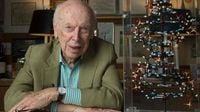James Watson, the American scientist whose name became synonymous with the discovery of DNA’s double helix structure, died on November 7, 2025, at the age of 97. Watson’s passing marks the end of an era for molecular biology—a field he helped shape with a discovery that would alter the course of science and medicine. Yet, his legacy is also shadowed by controversy, with remarks late in life that led to his estrangement from much of the scientific community.
Watson’s death was confirmed by Cold Spring Harbor Laboratory, the renowned New York research institution where he spent decades as a leader and researcher. According to the laboratory’s statement, Watson died in hospice care after a brief illness. His son also confirmed the news, noting that his father’s health had declined rapidly in recent weeks.
Born in Chicago on April 6, 1928, Watson’s fascination with the natural world began early. As a child, he was captivated by questions as simple as why birds migrate—a curiosity that propelled him into science. At just 15, Watson won a scholarship to the University of Chicago, where he graduated with a degree in zoology in 1947. He continued his studies at Indiana University Bloomington, earning a PhD and discovering a passion for genetics through his research on bacterial viruses.
Watson’s scientific journey led him to the Cavendish Laboratory in Cambridge, England, in 1951. There, he met Francis Crick, a British physicist-turned-biologist, and Maurice Wilkins, who was working on X-ray images of DNA. The trio, working with crucial data from British chemist Rosalind Franklin—whose X-ray diffraction images were obtained without her knowledge—pieced together the now-iconic double helix structure of DNA in 1953. This discovery, published in Nature, revealed how genetic information is stored and replicated, laying the foundation for modern molecular biology.
Reflecting on the moment of discovery, Watson once said, "Francis Crick and I made the discovery of the century, that was pretty clear." He later described the double helix as “so beautiful,” recalling the thrill of visualizing how DNA’s components could form the rungs of a twisted ladder. The image of the double helix would become an enduring symbol of scientific achievement.
In 1962, Watson, Crick, and Wilkins were awarded the Nobel Prize in Physiology or Medicine for their work. During the Nobel banquet speech, Watson remarked, “At that time, we knew that a new world had been opened and that an old world, which seemed rather mystical, was gone.” But the Nobel could not be awarded posthumously, and Franklin, who had died of ovarian cancer in 1958, was not recognized at the time. Only in later decades would her pivotal contributions be widely acknowledged—a point of ongoing debate and reflection within the scientific community.
Watson’s influence extended far beyond the discovery itself. After moving to Harvard, where he became a professor of biology, he published the textbook Molecular Biology of the Gene in 1965, a staple for generations of students. In 1968, he took the helm at Cold Spring Harbor Laboratory, transforming it into a world-class center for molecular biology research over a 25-year tenure. He was also the first director of the Human Genome Project, the international effort to map the entire human genome, until his resignation in 1992.
Watson’s personal life intertwined with his scientific pursuits. He married Elizabeth Lewis in 1968, and the couple had two sons, one of whom was diagnosed with schizophrenia as a teenager. This personal challenge motivated Watson to delve deeper into genetics, hoping to better understand and perhaps one day treat such conditions.
Despite his professional triumphs, Watson’s later years were marred by controversy. In 2007, during an interview with the Sunday Times, he claimed that people of African descent were less intelligent than whites due to genetics. The remarks sparked international outrage and led to his resignation as chancellor at Cold Spring Harbor Laboratory. Although he apologized “unreservedly,” the damage was done. In 2019, Watson repeated these views in a television interview, prompting the laboratory to strip him of all remaining honorary titles. The institution condemned his statements as “reprehensible” and “unsupported by science.”
The scientific community responded with disappointment and condemnation. Francis Collins, then director of the National Institutes of Health, said in 2019, “His outbursts, particularly when they reflected on race, were both profoundly misguided and deeply hurtful. I only wish that Jim’s views on society and humanity could have matched his brilliant scientific insights.”
Watson’s legacy is further complicated by his attitudes toward women in science. While some former colleagues noted that he supported the careers of female scientists at Harvard during the 1950s and 60s, he also made disparaging remarks about women, including sexist comments about Rosalind Franklin in his 1968 memoir, The Double Helix. The book, which became a bestseller, stoked controversy for its portrayal of Franklin and its account of the DNA discovery, further fueling debate over the recognition of women’s contributions in science.
In 2014, feeling ostracized by the scientific community, Watson became the first living Nobel laureate to sell his medal, raising $4.8 million at auction to fund research. In a surprising twist, a Russian billionaire purchased the medal and promptly returned it to Watson—a gesture that made headlines around the world.
Watson’s scientific achievements are undeniable. The discovery of DNA’s structure not only revolutionized biology but also made possible advances in genetic engineering, disease treatment, and forensic science. DNA evidence now plays a critical role in criminology, and gene therapy has opened new frontiers in medicine. Watson’s vision, drive, and intellect helped unlock the “secret of life,” as he and Crick famously declared in 1953.
Yet, the duality of Watson’s legacy remains inescapable. His insights into the molecular basis of life transformed science, but his public statements on race and gender left deep wounds and lasting controversy. As the world reflects on his passing, the story of James Watson is a reminder that scientific greatness and personal fallibility often coexist—sometimes uncomfortably—within the same life.






